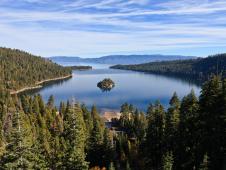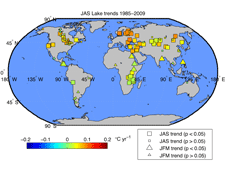 Lake Tahoe, seen here from Emerald Bay, was one of the primary validation sites for the global lake study. Image credit: NASA/JPL-Caltech
Lake Tahoe, seen here from Emerald Bay, was one of the primary validation sites for the global lake study. Image credit: NASA/JPL-Caltech
Researchers Philipp Schneider and Simon Hook of NASA's Jet Propulsion Laboratory in Pasadena, Calif., used satellite data to measure the surface temperatures of 167 large lakes worldwide.
They reported an average warming rate of 0.45 degrees Celsius (0.81 degrees Fahrenheit) per decade, with some lakes warming as much as 1 degree Celsius (1.8 degrees Fahrenheit) per decade. The warming trend was global, and the greatest increases were in the mid- to high-latitudes of the Northern Hemisphere.
"Our analysis provides a new, independent data source for assessing the impact of climate change over land around the world," said Schneider, lead author of the study published this week in the journal Geophysical Research Letters. "The results have implications for lake ecosystems, which can be adversely affected by even small water temperature changes."
Small changes in water temperature can result in algal blooms that can make a lake toxic to fish or result in the introduction of non-native species that change the lake's natural ecosystem.
Scientists have long used air temperature measurements taken near Earth's surface to compute warming trends. More recently, scientists have supplemented these measurements with thermal infrared satellite data that can be used to provide a comprehensive, accurate view of how surface temperatures are changing worldwide.
 Global trends in seasonal nighttime lake surface temperatures, 1985-2009. Image credit: NASA/JPL-Caltech
Global trends in seasonal nighttime lake surface temperatures, 1985-2009. Image credit: NASA/JPL-Caltech
The NASA researchers used thermal infrared imagery from National Oceanic and Atmospheric Administration and European Space Agency satellites. They focused on summer temperatures (July to September in the Northern Hemisphere and January to March in the Southern Hemisphere) because of the difficulty in collecting data in seasons when lakes are ice-covered and/or often hidden by clouds. Only nighttime data were used in the study.
The bodies studied were selected from a global database of lakes and wetlands based on size (typically at least 500 square kilometers – 193 square miles – or larger) or other unique characteristics of scientific merit. The selected lakes also had to have large surface areas located away from shorelines, so land influences did not interfere with the measurements. Satellite lake data were collected from the point farthest from any shoreline.
The largest and most consistent area of warming was northern Europe. The warming trend was slightly weaker in southeastern Europe, around the Black and Caspian seas and Kazakhstan. The trends increased slightly farther east in Siberia, Mongolia and northern China.
Click here to read the entire article